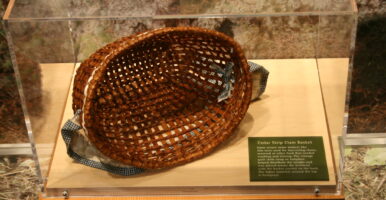(5 minutes reading this part of the post only)
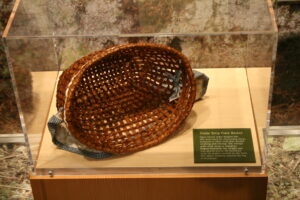 “Cedar Basket” by born1945 is licensed under CC BY 2.0
“Cedar Basket” by born1945 is licensed under CC BY 2.0
When someone says they are a weaver, immediately an image of someone working a loom comes to mind. Yet, basket weaving is possibly one of the oldest human crafts. Baskets were fashioned out of whatever natural materials were found at hand: trees, bushes, vines, and grasses, and used to carry everything from food to water. Today, willow, oak, and cattails are not used nearly as often as reeds and vines bought at the store. Basket reed, also called rattan, has largely replaced the vines and grasses used long ago.
 “FMSC MarketPlace – Pine Needle Basket” by Feed My Starving Children (FMSC) is licensed under CC BY 2.0
“FMSC MarketPlace – Pine Needle Basket” by Feed My Starving Children (FMSC) is licensed under CC BY 2.0
Pine needle basketry, using needles such as the 18cm long Ponderosa pine needle, is an inexpensive hobby as much of the supplies can be picked from a tree without damaging the tree. This type of basket making was used as therapy in hospitals such as the sanatoriums, including the Kamloops sanatorium, during the tuberculosis (TB) epidemic. Treatment of TB consisted of much rest plus interesting hobbies of a non-physical nature.
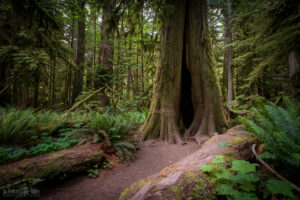 “The Hollow Tree, Cathedral Grove” by glendon27 is licensed under CC BY-NC-SA 2.0
“The Hollow Tree, Cathedral Grove” by glendon27 is licensed under CC BY-NC-SA 2.0
Tla’amin baskets, built with the purpose of packing food, storing goods or even as baby cribs, are very beautiful pieces of Indigenous peoples art [web page]. Expert Tla’amin cedar root basket maker Rose Mitchell explains that production of the baskets reached its peak in the late 1800s when Sliammon women learned the art of basketry from Interior Salish women. Cedar is considered the tree of life by the Ts’msyen people. In Sm’algya̱x, the Ts’msyen language, the name for cedar is smgan which means real or true tree. Traditionally, for the Ts’msyen and many other coastal First Nations ̱ peoples, it provided materials needed for everyday living such as clothing, shelter, transportation, storage and utensils. The inner bark of cedar was/is used to create clothing that meets many needs – soft and warm or tightly woven and waterproof when needed for the wet coastal climate. It was/is also used for spiritual and ceremonial purposes. Woven cedar is an essential component of regalia (ceremonial dress) and can take the form of hats, capes, bracelets and headbands. Woven cedar mats were also traditionally used to wrap loved ones after death before placing them in bentwood boxes.
There are two native species of cedar tree that grow in the temperate rainforests of coastal British Columbia: Yellow Cedar and Western Red Cedar. Yellow Cedar typically grows at subalpine elevations in damp coastal forests ranging from Vancouver Island to Alaska; but it is rarely found in inland regions. Red Cedar is common both on the coast and in moist slopes and valleys of the Interior. The inner bark of both types of cedar is used for weaving. Yellow cedar was usually used for clothing worn next to the skin because it is softer. Red cedar was used for outer clothing such as rain hats and capes. Red cedar was also most commonly used for baskets and mats.
In the late spring or early summer, when the sap is running and the bark is easier to peel off, people go out to collect cedar bark. They select a tall, straight tree with few branches at the base. They thank the tree for sharing its bark and only take enough bark to meet their needs without harming the tree. Only a small amount of bark can only be harvested from each tree and each year, new trees must be found for harvesting. When it is used for clothing, the bark is separated, pounded, and shredded, to make it soft. The shreds are rolled together to the correct thickness for weaving into clothing. Bark used for weaving hats, baskets, and mats is split into thin strips.
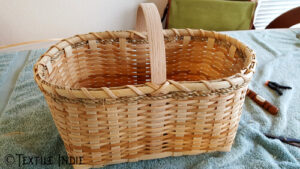 Gathering basket from Textile Indie
Gathering basket from Textile Indie
Situation: You decide you want to make a basket for your teacher so they have something special to carry their laptop and supplies from class to class. There are math skills you are going to need in order to accurately calculate how much supplies you need. You want a fairly accurate answer so you don’t waste money buying too much. Note that not being exact and rounding too soon creates an unrealistic and inaccurate amount.
For example, let’s say you were supposed to be charged 5.4% interest on a $100,000 loan. You were paying monthly so the bank divided the interest by 12 months and got the answer of 0.45% for a monthly interest rate. They decided to round it to 0.5%, which means you would actually pay 6% interest over the year! After rounding, they rounded again, since they didn’t want to deal with a decimal, which meant they were charging 1% a month or 12% a year! A small rounding error makes a huge difference, so it is best to deal with surds and then round your final answer.
There are many examples of rounding errors [web article] as well.
01.05.01 What types of numbers are used to be exact?
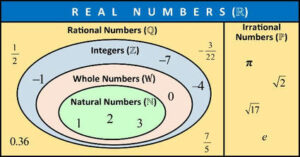 You will need to understand about irrational numbers, surds, roots, and radicals, and how to simplify surds and radicals. What are they? The definitions of the different types of numbers that will be referred to in future math questions can be found on the Bahamian mathematics webpage from which the image on the left has been taken. The Khan Academy video (6 minutes) on the page helpful as are the notes and the slideshow at the bottom. The worksheets do not include keys, so you may want to watch a further Khan Academy video (9 minutes) and do the exercises that follow. This flexbook has a very clear explanation of what irrational numbers are as well as an interactive tool to help you make sense of square roots that don’t have a rational number root. This video (9 minutes) from MyWhyU is an entertaining explanation of the history behind the different types of numbers.
You will need to understand about irrational numbers, surds, roots, and radicals, and how to simplify surds and radicals. What are they? The definitions of the different types of numbers that will be referred to in future math questions can be found on the Bahamian mathematics webpage from which the image on the left has been taken. The Khan Academy video (6 minutes) on the page helpful as are the notes and the slideshow at the bottom. The worksheets do not include keys, so you may want to watch a further Khan Academy video (9 minutes) and do the exercises that follow. This flexbook has a very clear explanation of what irrational numbers are as well as an interactive tool to help you make sense of square roots that don’t have a rational number root. This video (9 minutes) from MyWhyU is an entertaining explanation of the history behind the different types of numbers.What are surds and radicals?
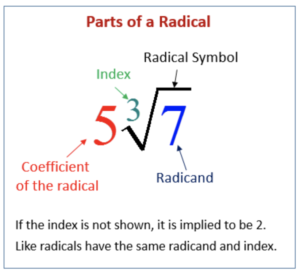 Image from https://www.onlinemathlearning.com/adding-radicals.html
Image from https://www.onlinemathlearning.com/adding-radicals.html
Learning about surds and radicals
OR
You may find it helpful to review perfect squares and perfect cube roots as well as how to estimate roots (13 minute online video).
If you do not want to watch videos and just want to read, this article [web page] thoroughly covers radicals. (9 minutes reading)
Learning how to simplify entire radicals to mixed radicals
Learning how to write a mixed radical as an entire radical
Learning how to add and subtract radicals
Learning how to multiply and divide radicals
Practicing

- Simplifying radicals [web page] (You can add 4th and 5th roots)
- Adding and Subtracting Radicals [web page]
- Multiplying Radicals [web page]
- Dividing Radicals [web page]
Kahoot! is an online platform that allows you to test yourself. Use a false name and don’t sign in as it is unnecessary.
01.05.02 How can I calculate a project’s supplies accurately?
- length:

- width and height:

Hint for Calculating Supplies
Key for Calculating Basket Supplies
Basket Key Google Doc or Basket Key pdf .
Resources
Basket-making basics – Basketry for beginners – Homestead.org. (2020, June 23). Homestead.org. https://www.homestead.org/lifestyle/basket-making-basics/
Calder, T. (2020) Weaving our Way From Patterns to Linear Relations in a Ts’msyen Context. Aboriginal Education Department, SD 52 (Prince Rupert). https://29ec2a20-d7c2-4c63-9e11-6a4768b6be49.filesusr.com/ugd/d810a6_dde8a7a3e72d4d608b4820697fe75f4c.pdf
Erickson, J. Pine Needle Basketry. (2018, June 8). Salmon Arm Arts Centre. http://www.salmonarmartscentre.ca/wp-content/uploads/2018/08/Pine-Needle-Basketry-by-June-Erickson-2018.pdf
First Nations Education Steering Committee. (2020) Math First Peoples Teacher Resource Guide. http://www.fnesc.ca/wp/wp-content/uploads/2020/09/PUBLICATION-Math-FP-TRG-2020-09-04.pdf
Jungic, V. (2019, January 23). Indigenous basket-weaving makes an excellent digital math lesson. The Conversation. https://theconversation.com/indigenous-basket-weaving-makes-an-excellent-digital-math-lesson-110094
Step-by-step guide to weaving a handled basket. (2021, January 19). Textile Indie. https://www.textileindie.com/weaving-basket-guide/
For Teachers:



